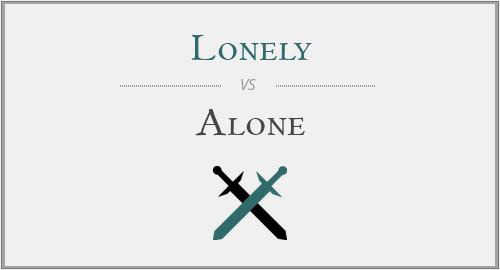Everyone knows what "lonely" and "alone" both refer to: a single person, not surrounded by people. It's about the state of being only "one". But the fact that they do refer to the same concept is also the cause of many errors in the English vocabulary. Because they are spelled similarly and have quite similar meanings, people also tend to replace them regardless of the context - which shouldn't happen.
"Lonely" and "alone" might have similar definitions, by they are not identical. Some subtle differences between them create different usage requirements. Let's see which these are and eliminate potential confusions.
Lonely vs. Alone
So what you have to remember as a main and essential difference between "lonely" and "alone" is that you "feel lonely" and you "are alone". More exactly, "lonely" is a feeling, whereas "alone" is a state of being. "Lonely" is the feeling of sadness caused by not having someone around, while "alone" defines exactly the condition of actually not having someone around.
To clear it up in the shortest possible way to remember, you feel "lonely" because you are "alone". Being "lonely" is an effect, a feeling caused by being "alone".
When do we use "lonely"?
"Lonely" is used as an adjective. Below there are two main contexts where you can use "lonely" to describe the feeling of unhappiness caused by not being with other people.
Example 1: She felt so lonely and sad, whenever her kids left the home for more than a week. - "lonely" is a feeling of unhappiness felt by someone due to not being with other people.
Example 2: There is a lonely place down this river, no people live within a distance of 5 kilometers. - "lonely" can also describe a silent place, far from other people.
When do we use "alone"?
"Alone" again is used in two different contexts, and we'll explain them using the examples below:
Example 1: When I'm alone in a silent place, that's when I'm inspired to write and create my art. - "alone" basically defines the state of not having anyone around, of not being surrounded by other people.
Example 2: Last week alone, we had an increase of 96.5% in our sales. - with a secondary meaning, "alone" can also be used to emphasize that only one person or thing is discussed about or involved into something.
Conclusion
Although both "lonely" and "alone" refer to the same aspect of being without other persons, there is a notable difference in the way you should use these similar words in sentences in order to not create confusions or errors. What it's essential and actually a key to remembering when to use each correctly, is that you "feel lonely" because of the fact that you are "alone".





Have a discussion about this article with the community:
Report Comment
We're doing our best to make sure our content is useful, accurate and safe.
If by any chance you spot an inappropriate comment while navigating through our website please use this form to let us know, and we'll take care of it shortly.
Attachment
You need to be logged in to favorite.
Log In